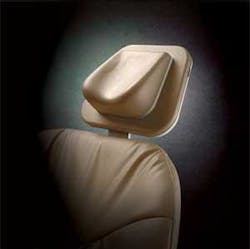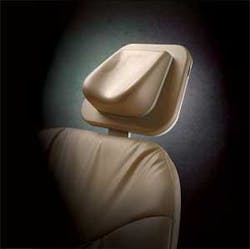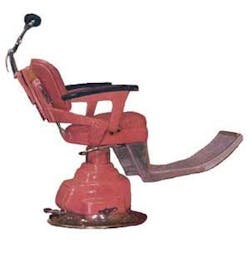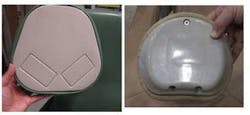Magnets in dental chairs
Warning for dental professionals
by Judy Bendit, RDH, BS
Most dental professionals have never thought that their dental chair could be a risk to patients with pacemakers or implantable defibrillators (ICDs). They need to think again. A few months ago, Boston Scientific, one of the major manufacturers of pacemakers/ICDs, added a new caution to their contraindications for dental patients. They warn that if a patient has a pacemaker/ICD, and the dental chair has a magnetic headrest with strength over 10 gauss, the patient should NOT sit in the chair.
The company states: “Some dental chairs contain magnets located in the headrest. If the pacemaker or defibrillator is programmed not to respond to a magnet, patients may sit in these chairs. If the implanted device is programmed to respond to a magnet and the magnet power is less than 10 gauss, patients may sit in these chairs. If the magnet power is greater than or equal to 10 gauss, patients should not sit in these chairs as the device function/programming may be affected.”
Allow me to explain. Magnet strength is measured in gauss units. The farther the distance from the magnet, the weaker the gauss reading, which means a weaker magnetic field. The magnets on dental chairs currently in use contain magnets with strength over 400 gauss. (Strengths vary slightly among manufacturers.) Therefore, sitting in the typical dental chair with a pacemaker/ICD, one would have to be five to six inches away from the magnet to be safe. Sometimes, however, dental professionals have trouble accessing certain parts of the mouth, and we ask patients to move up in the headrest, which is closer to the magnet. When we get too close to the magnet, the magnetic effect increases, and therefore, so does the potential for complications.
Historical information
Today there are over three million patients worldwide with an implantable cardiac device, and over 600,000 are inserted each year. The first pacemaker was implanted in 1958.5 For many years these pacemakers were not shielded and were unsafe anywhere near a magnetic field. According to the manufacturers, significant changes were made in the 1980s. Today, advances in these devices include a titanium casing, signal filtering, interference rejection circuits, noise reversion functions, a bipolar sensing mode, and programmable parameters.6 This makes exposure to some low–level magnetic fields safe without causing disruption to the device.
Many of you may recall the days when patients with pacemakers couldn't go into stores or restaurants with microwaves. According to St. Jude's Medical, if the microwave was manufactured after 1968, there is no longer an issue. There was also a concern regarding the use of ultrasonic scalers on these patients. Due to the finite lifespan of these devices, representatives from Boston Scientific, St. Jude's, and Medtronics claim that it would be virtually impossible for any patient to still be walking around with an unshielded pacemaker because the battery could not last that long. Patients today receive a card that describes the type of pacemaker/ICD, including date of insertion, and they are asked to carry it with them at all times. It is still strongly recommended to contact a patient's cardiologist for clearance. Keep in mind that implantable devices are not used only in the elderly. Although uncommon, pacemakers /ICDs can be used in patients of any age, including children.
Now let's review the concerns about the magnetic headrest. Along with the advancements listed above, most pacemaker/ICDs have a small magnetic activation switch built into them. When a magnet is placed near the pacemaker/ICD, it disables the device's sensing capabilities. This inhibits the detection of any arrhythmias, and it will not deliver the appropriate therapy. When this happens, the pacemaker could return to a default mode and not pace at the rate the cardiologist has set it (asynchronous pacing), or the pacing may be inhibited altogether. This could lead to bradyarrythmia (slow heart rate). If bradyarrythmia occurs and cardiac output drops too low, there will be an insufficient blood supply to the brain. The patient could experience fainting, dizziness, fatigue, or shortness of breath. When this occurs, the patient should hear beep tones to warn him or her that the unit is not functioning properly. Staying too close to the magnet for an extended period could also deplete the battery life in the device.1,4 When the patient is moved farther away from the magnet, the symptoms will go away and the pacemaker should return to normal.2
The ICD, on the other hand, is used to deliver sufficient energy to terminate a dangerously fast heart rate, ventricular tachycardia (VT), or ventricular fibrillation (VF). When a VT or VF is detected, a precisely calibrated electrical shock is delivered to treat the arrhythmia and restore normal heart rhythm.6,7 When the internal switch is closed in the ICD, in the presence of a strong enough magnetic field, it will disable the arrhythmia detection and treatment function, which leaves patients in a vulnerable position if they were to have a cardiac incident while you are treating them.1,4
Patients are told when they get their pacemaker/ICD to avoid magnets, but how many of them would be aware that a strong magnet is hidden inside your dental chair? As magnets are being used more frequently, companies are being instructed to place better warnings on these items. Very strong magnets are showing up on clothing clasps, name tags, work badges, toys, jewelry, cell phones, eye glasses, headphones, electric blankets, and many other items. Studies show that these items contain magnets that produce a magnetic field strong enough to produce potentially hazardous events.1
Who manufactures magnetic chairs and why?
A–dec, Pelton & Crane, DentalEZ, Midmark, and Serona all manufacture chairs with a magnetic headrest, which is part of the standard line of chairs for DentalEZ, Midmark, and Serona. A–dec and Pelton & Crane sell magnetic headrests only by special request. These chairs were initially made in the 1970s and 1980s, when the transition from stand–up to sit–down dentistry prompted calls from clinicians to do away with the bulky ratchet on the back of the headrest. Manufacturers responded by designing a thin backed headrest that had a strong magnetic adjustable pillow.
Recommendations
Don't panic. The magnets are in the pillow. (See two photos below. )
Boston Scientific suggests sitting in another chair, but that's not necessary. The easiest solution is to take the pillow off the chair and move it away from the patient. I recommend displaying a placard that informs patients that if they have a pacemaker/ICD to please notify the dental professional so appropriate steps can be taken. An office protocol for treating these patients should be established. The next time a patient with a pacemaker/ICD complains of dizziness, lightheadedness, or shortness of breath, don't assume it's anxiety from sitting in your chair. The magnetic headrest may be the culprit.
Judy Bendit, RDH, BS, likes to say she was “born and raised in a dental office.” With over 35 years of experience in dentistry, Bendit, a dental education consultant, travels extensively as a national speaker for a number of dental manufacturers. She is on the faculty at Temple University–Maurice H. Kronberg School of Dentistry, as well as an advisory board member at Harcum College School of Dental Hygiene in Bryn Mawr, PA. She is a long–standing member of ADHA and Distinguished Academy member of the Pennsylvania Dental Hygiene Association. She can be reached at [email protected].
Author's Note: Further questions regarding pacemakers/ICDs can be directed to the manufacturers of the devices, including Boston Scientific (1–800–CARDIAC), Medtronics (800–505–4636), and St. Jude's Medical (800–722–3774). They are happy to provide a sheet with contraindications for dental treatment.
References
- Wolber T et al. Potential interference of small neodymium magnets with cardiac pacemakers and implantable cardioverter–defibrillators, Heart Rhythm 4 (2007).
- Wood M, Ellenbogen K. Cardiac Pacemakers from the Patient's Perspective. Circulation, 2002;105:2136. American Heart Association.
- “A Closer Look,” Product education at a glance. Boston Scientific, Dental Equipment and Implantable Pacemakers and Defibrillators (2009).
- Li H. Magnet decorations, beautiful but potentially dangerous for patients with implantable pacemakers or defibrillators. Heart Rhythm 2007, doi:10.1016/j.hrthm.2006.09.026.
- Miller C, Leomelli F, et al. Selective interference with pacemaker activity by electrical dental devices. Oral Medicine, Vol. 85(1), January 1998, 33–36.
- Brand HS, Entjes ML, et al. Interference of electrical dental equipment with implantable cardioverter–defibrillators, British Dental Journal, v.203, no.10, November 2007.
- Rozner MA, Trankina MF: Intrathoracic gadgets: Update on pacemakers and implantable cardioverter defibrillators. Refresher Courses in Anesthesiology. American Society of Anesthesiologists. 2000;28:183–199.



